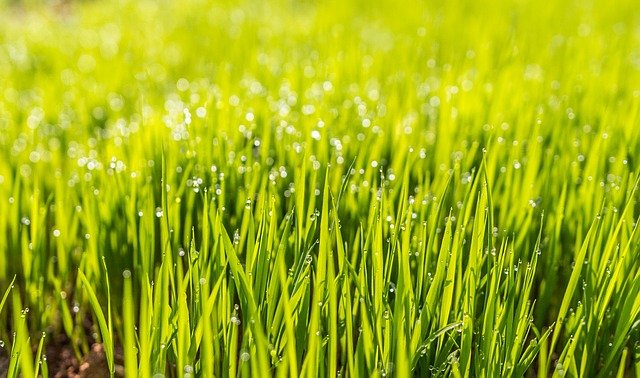
Lawns can flourish if you know how to treat them right and give them the time, care, and attention that they need.
A lush, thick lawn bursting with green blades of grass requires a balanced diet and careful planning. Grass can't stay healthy without a bit of work.
Understanding when and how to feed your lawn (and what nutrients it needs) is vital if you want to achieve the picturesque lawn that every homeowner dreams of. Not quite sure when to fertilise your lawn? Don't panic - Lawn & Weed Expert is here to help!
Scroll down to read our expert guide to lawn fertilisation.
Starting a new lawn from seed
Not every homeowner has an established lawn that they can look to repair. Instead, you may need to grow your lawn from seed. If you fall into this bracket, then applying a starter fertiliser will help give your lawn get the kickstart it needs.
Unlike already established lawns, new grass can take advantage of any extra phosphorous given. This is an essential plant nutrient that helps to develop strong, deep roots. Using a lawn fertiliser that contains a healthy mix of phosphorous and other essential nutrients such as nitrogen and potassium before planting seeds is the best way to go.
Be sure to avoid using weed and feed fertilisers within four weeks before planting your new lawn seeds. Once you've finished seeding, wait until your lawn becomes established and you've mowed it at least three times before applying.
Fertilising an established lawn
When it comes to lawn fertilisation on an established lawn that you'd like to reinvigorate, here's when you'll need to establish a new fertilising plan that helps your lawn look good year-round.
Early Spring
The first time to apply fertiliser to your lawn is during the early parts of spring, usually between February and April when the temperatures begin to rise and weed and seeds start to germinate. Here you can prevent new weeds from establishing, controlling them for up to five months while feeding your lawn with the essential nutrients that it needs.
For sure the most important thing for spring lawn fertilisation is timing. Ensure you apply your fertiliser before the crabgrass seed germinates, which is usually when your soil reaches 12 degrees celsius in temperature. To gain optimum results, apply your fertiliser with a spreader to turf that is actively growing, giving your lawn at least half an inch of water from rainfall within two weeks.
Late Spring
The next time to fertilise your lawn is during the later part of spring, usually between April and June where existing weeds jump into active growth. Weed and feed fertilisers mentioned above combine nutrients with broadleaf weed killers to feed your growing lawn.
We recommend always double-checking the labels on your weed and feed fertilisers for your specific type of grass and following the instructions it provides carefully. For optimum results, apply your weed and feed to your lawn during the early morning when grass blades are wet with dew and no rain is forecast for a couple of days.
If planning to overseed, avoid applying your weed and weed for around four weeks prior. Once you've finished overseeding, wait until you've mowed your lawn three times.
Summer
During the summer months, proper lawn feeding helps to strengthen your grass against issues such as heat and drought. Using a premium lawn fertiliser for around three months between June and August will ensure your lawn receives the essential nutrients that it needs to become the thick, green meadow you want.
Again, always check the fertiliser label for your grass type and follow the instructions accordingly.
Late Summer to Late Autumn
During the late summer to late autumn (between August and November) your lawn begins to slow down its growth in preparation for the winter, while broadleaf weeds simultaneously start their active growing.
With weed and feed fertiliser, you again can feed your lawn the nutrients it needs for the winter whilst eliminating broadleaf weeds. We recommend allowing up to six to eight weeds between fertilising and the first expected frost of your lawn.
*
So, if you're not sure when to fertilise your lawn, following these four lawn fertilisation tips will ensure your lawn is given the best chance to transform into the glowing green meadow you've always wanted!
If you still need additional information on when to fertilise your lawn, visit our page below to learn all about the lawn fertilisation services that we offer here at Lawn & Weed Expert.
Lawn Fertilisation Services >
If you'd like to discuss lawn fertilisation with one of our experts, then please do not hesitate to contact us today - we'd be more than happy to help with any questions you may have.